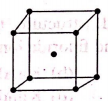The edge length of the unit cell of NaCl crystal lattice is 552 pm. If the ionic radius of sodium ion is 95 pm. What is the ionic radius of chloride ion?
1. 181 pm
2. 190 pm
3. 276 pm
3. 368 pm
The second order Bragg diffraction of X-rays, with from a set of parallel planes in a metal, occurs at an angle of The distance between the scattering planes in the crystal is
1. 2.00 Å
2. 1.00 Å
3. 0.575 Å
4. 1.15 Å
The closest distance between two atoms (in terms of edge length) would be highest for which of unit cell, assuming the edge length of each unit cell be 'a'
1. FCC unit cell
2. BCC unit cell
3. diamond unit cell
4. primitive cubic cell
A X+ Y- has the Y- ions arranged as below. If the X+ ions occupy half of the tetrahedral sites in the structure. The formula of solid is

1. XY
2. X3Y4
3. XY2
4. X2Y
A solid XY has NaCl structure. If radius of X+ is 100 pm, the radius of Y- ion is
1. 136.6 to 241.6 pm
2. 341.6 to 134.6 pm
3. 128 pm
4. 136.8 pm
The ionic radii of Rb+ and I- are 1.46 Å and 2.16 Å respecitvely. The most probable type of structure exhibited by it is
1. CaF2 type
2. ZnS type
3. CsCl type
4. NaCl type
A solid has 3 types of atoms namely X, Y and Z. X forms an FCC lattice with Y atoms occupying all the tetrahedral voids and Z atoms occupying half the octahedral voids. The formula of the solid is
1. XYZ
2. X2Y4Z
3. X4YZ2
4. X4Y2Z
Calculate the of X-rays which give a diffraction angle 2 for a crystal. (Given interplanar distance=0.200 nm; diffraction=first order; sin =0.1461)
1. 58.4 pm
2. 5.84 pm
3. 584 pm
4. 648 pm
In a compound XY, the ionic radii X+ and Y- are 88 pm and 200 pm respectively. What is the coordination number of X+?
1. 4
2. 6
3. 8
4. 10






